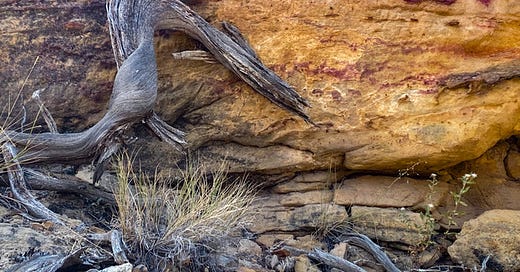If a tree is pretty in the forest and nobody is there to see it, is it art?
A tiny juniper's journey to big-idea places
Last summer, the writer John Manuel sent me this photograph. He’d been exploring a remote canyon, hoping to see petroglyphs that others had reported there. In hours of searching, he and his companions found only one petroglyph, and it was very faint. “That was really disappointing,” he said.
It was still a pleasant day, he said, filled with “hoodoos that looked like mythical beasts [and] multi-colored rock walls.” In one of the day’s most vivid moments, he saw this juniper stump and said, “Now, that’s art!”
I asked how he could tell.
I’m sure I was annoying. But especially in regard to nature, the question has long puzzled me: What is art? Is it timeless beauty, such that this juniper tree exists as art even in moments when no humans are around to gaze upon it?
Or does the recipient matter? Does the beauty have to land somewhere? In which case, if Sue perceives beauty differently than Betty does, would Sue and Betty have different ideas of which natural scenes qualify as art? In other words, if Sue believes a clearcut is beautiful, does that clearcut gain the same status—the same moral equivalence—as a wilderness?
Or does art go beyond the pretty or enjoyable? When I wrote last winter about a potential Poptimist revolution in nature writing, the poet Marc Beaudin liked the essay while basically disagreeing with it. “I think it's okay to maintain that… pop music is fun and entertaining and that people enjoy it, which is all fine; but that doesn't make it art,” he told me.
Why? Because, Marc said, “Art must challenge, question, inspire, cause an emotional/psychological reverberation, and ultimately change who we are in relation to the world. I think nature/wilderness does all [those] things.”
I found that argument quite powerful. When I think about my favorite works of art (in my case, mostly books), they are works that changed me.
But when I ran all this past John, he had yet another interpretation. “For me, intentionality is important. I would not say the juniper stump as it exists in nature is art. But if I take it home and hang it on my wall (as I’ve done with many natural objects) it then in my mind becomes art. Why? Because I intend it to be. I perceive it as such.”
This too struck a chord with me: Thirty-four years ago, I had business cards printed up that said: “John Clayton: Writer.” I had no publishing record to speak of, no job or contract as a writer. But I intended to be one. I perceived myself as such. Regardless of what any gatekeepers might say, this was my identity. Shouldn’t the same hold for art?
A century ago, Americans could avoid all these conundrums by saying, “God did it.” The Judeo-Christian God was both Creator and Recipient, both Artist and Observer, owned both the intentionality and the desire to change who you are in relation to the world. The existence of beauty in nature—the art—was evidence of an all-powerful loving God.
Although not a religious person, John was tempted to go there, himself. “How about a fabulously-colored bird like the Western tanager? Is that bird not a work of art?” he asked me. “I am tempted to say there is some force in the universe that recognizes ‘beauty’ and causes it to come about.”
I too am the sort of nonreligious, nonconfrontational person who uses phrases such as “some force in the universe.” For example, I myself believe in the timeless-beauty angle on the juniper. I believe it’s art not just when domesticated by the photograph or hung on someone’s wall. To me, it’s art in the location where it exists, always. I’ve seen millions of similar artworks, and the opportunity to experience them explains a lot about why I live in a small Montana town close to nature. Vaguely ascribing it all to “some force in the universe” seems a handy way to get out of potentially intractable arguments.
Yet as I stare at that photograph and tell this story, it strikes me that this is one of the biggest challenges our 21st century democratic/scientific society faces. How do we form a right relationship with that juniper stump? Especially when so many of us seem so unwilling to articulate a common relationship to a specific spiritual force?
Here’s hoping that stories like these are a start.
Discussion:
In an early draft, I called Sue and Betty “Floyd” and “David” in homage to John McPhee’s classic Encounters with the Archdruid (that’s an affiliate link).
Thanks to Tidings of Magpies magazine, which recently reprinted one of my earliest natural stories, “I have a gun, she lied.”





If art is an experience, not just an object (here I stand with John Dewey) then your experience of the juniper is an experience of art (beauty) and so, too, is your essay seeking to understand your reaction to the tree.
But as Dewey would say (I think, I am a student of this, not a master) as soon as we introduce the idea of an external force (THE force, a la Star Wars?), the juniper is no longer art, but a greatly reduced , out-of-context object that may as well have been winked into existence the moment before you saw it. And that is not natural.